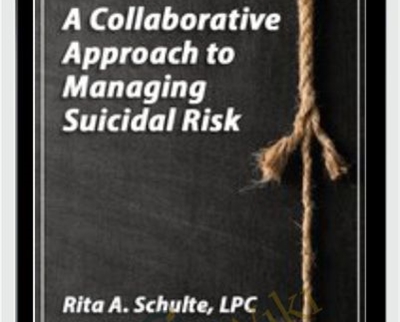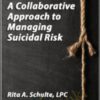$119.99 Original price was: $119.99.$43.00Current price is: $43.00.
With 71 percent of therapists reporting at least one client whose attempted suicide, helping people teetering on the precarious edge of suicidal ideation is one of the most important and scariest aspects of our work.
 Purchase this course you will earn 43 Points worth of $4.30
Purchase this course you will earn 43 Points worth of $4.30Elevate your skills with the A Collaborative Approach to Managing Suicidal Risk – Rita Schulte course, available for just $119.99 Original price was: $119.99.$43.00Current price is: $43.00. on Utralist.com! Browse our curated selection of over 60,000 downloadable digital courses across diverse Uncategorized. Benefit from expert-led, self-paced instruction and save over 80%. Start learning smarter today!
With 71 percent of therapists reporting at least one client whose attempted suicide, helping people teetering on the precarious edge of suicidal ideation is one of the most important and scariest aspects of our work. This recording will give you a comprehensive road map for navigating assessment, treatment, and management for those at risk for suicide, as well as how to nurture a survivor’s potential for healing and resilience.
- Assess current statistics on suicide and identify signs and symptoms that indicate suicidal ideation.
- Analyze the CAMS Model for suicidality as it relates to clinical practice.
- Apply DBT, CBT, and other interventions to help clients emotionally regulate.
- Determine the clinical implications of specific strategies that foster adaptation and resiliency, including somatic resourcing, remembered resources, art, writing, and mindfulness.
- Differentiate common emotional and spiritual issues that survivors of complex trauma face, and discuss evidence-based strategies to help them rediscover personal strengths and the resiliency to move forward.
Piercing the Darkness: Assessment, Treatment, and Management of Suicide Risk
Explore current statistics on suicide and identify signs and symptoms that indicate suicidal ideation
- Drawing from news and media clips, see how suicide is on the rise for not only the elderly but for the nation’s youth
- Become aware of the current statistics on suicide
- Identify warning signs
- Identify environmental factors as well as genetic predispositions
- Understand how stigma affects clients
Explore the 3 Areas of Impact Vulnerability for Suicide
Traumatized Brain:
- The neurobiology of the traumatized brain
- How to Calm the Overactive Brain of your Client
- Affect Regulation skills
- Breathing
- Mindfulness techniques and the Art of Noticing
- Grounding techniques
Guilt/Shame:
- Meaning making—Can they make sense of their story?
- Can they find bigger plan or purpose?
- How does shame affect the way the client lives?
- In what story is the client living? What conclusions has client drawn about the self?
Existential Shattering: Crisis of belief
Explore the concept of Alongside
- Cultivate social engagement and connection
- Using Story and Metaphor (Narrative Therapy)
- Learn how to use Presence, Patience and Planting Seeds
Explore DBT, CBT and other interventions to help clients emotionally regulate
- Mindfulness: being self -aware and learning to exhibit impulse control
- Distress Tolerance: Learning to handle stressful emotions
- Emotional Regulation
- CBT—use Dysfunctional Thought Record/Beck Depression Inventory/Assess Client self-talk
- Identify irrational beliefs
- 5 R’s
- Recognize/Refute/Reframe/Reflect/Rewire
Explore the CAMS Model for suicidality
- Explore the 5 stages of the CAMS model for treating suicidality
- Be able to identify primary and secondary suicide drivers
- Help clients enlarge their world with the PIE of life
Learn tools to help clients become more resilient
- Explore the concept of resiliency
- Learn 3 keys to Self-Compassion
Explore a list of specific strategies that foster adaptation and resiliency, including somatic resourcing, remembered resources, art, writing and mindfulness
- Self-Compassion
- Art therapy
- Journaling
- Somatic Resourcing
- Remembered Resource
- Alternate Nostril Breathing
- Jar of Grief
- Phototherapy
Get A Collaborative Approach to Managing Suicidal Risk – Rita Schulte, Only Price $47
Tag: A Collaborative Approach to Managing Suicidal Risk – Rita Schulte Review. A Collaborative Approach to Managing Suicidal Risk – Rita Schulte download. A Collaborative Approach to Managing Suicidal Risk – Rita Schulte discount.
Cultivate continuous growth with the A Collaborative Approach to Managing Suicidal Risk – Rita Schulte course at Utralist.com! Unlock lifetime access to premium digital content, meticulously designed for both career advancement and personal enrichment.
- Lifetime Access: Enjoy limitless access to your purchased courses.
- Exceptional Value: Benefit from savings up to 80% on high-quality courses.
- Secure Transactions: Your payments are always safe and protected.
- Practical Application: Gain real-world skills applicable to your goals.
- Instant Accessibility: Begin your learning journey immediately after buying.
- Device Compatible: Access your courses seamlessly on any device.
Transform your potential with Utralist.com!
Related products
= 85 Points
Uncategorized
= 85 Points
Uncategorized
Managing Patient Emergencies: Critical Care Skills Every Nurse Must Know – Dr. Paul Langlois
= 85 Points
Uncategorized
= 35 Points
= 94 Points
= 125 Points
Uncategorized
= 85 Points
Uncategorized
= 35 Points





